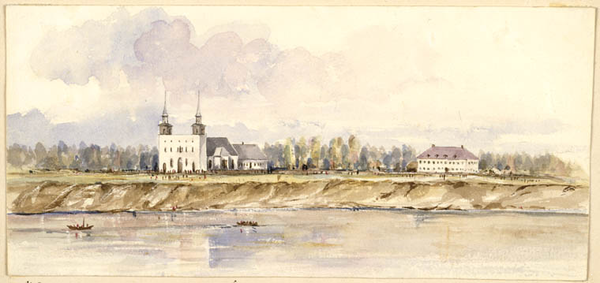- From the Red River Settlement to Manitoba (1812—70)
- Maps
- The Earl of Selkirk: The Colony’s Founder
- An Arduous Task, Marked by a Private War (1812—21)
- The Métis
- Indigenous Peoples
- Colonial Administration
- Maintaining Order and the Colony’s Defence
- Of Fur and Wheat: Subsistence and the Economy
- From Canoes to Railways: Transportation
- Life in Red River
- Missions and Religious Life
- Education, Health, and Social Assistance
- Arts and Culture
- The Press
- Intellectual and Scientific Life
- Winnipeg: The Emergence of an Urban Core
- Debating the Status of the Colony (1850—70)
- The Red River Rebellion and the Creation of Manitoba, 1869—70
- Suggested Readings on the Métis
Missions and Religious Life
At the height of the pemmican war [see An Arduous Task, Marked by a Private War (1812–21)], Thomas DOUGLAS, 5th Earl of Selkirk, believed that the establishment of a mission would stabilize the young colony and help restore order. It was in this context that the first Roman Catholic priests settled at Red River, as recalled in the biography of one such man, Joseph Norbert PROVENCHER, the region’s future bishop:
“In 1816 Selkirk and Miles
“Provencher, [the priest Sévère] Dumoulin, and [the seminarist William] Edge left Montreal on 19 May 1818, and on 16 July reached Fort Douglas (Winnipeg), where the governor of Assiniboia, Alexander
Converting and educating Indigenous people, evangelizing among the settlers (especially the Métis), seeing to their spiritual needs, and obtaining support from the authorities in the thick of strong rivalry between religious faiths: these were some of the responsibilities of missionaries such as William COCKRAN, a Protestant, after the end of the pemmican war in 1821:
“Cockran arrived in the settlement at a critical juncture in the affairs of the Anglican mission and the development of Red River. The Reverend John
Missionary work among Indigenous people was marked by competition between Roman Catholics and Protestants, as related in the biography of the Catholic missionary Jean-Baptiste THIBAULT:
“[In 1835], in the bishop’s absence, Thibault showed himself to be a wise and skilful administrator of the western missions. The building of the cathedral at Saint-Boniface progressed, and the yield from the farm belonging to the mission increased. Thibault proved to be a good preacher, without being too verbose. Above all, he was good at expounding; this quality was appreciated by Bishop Provencher, who considered that Christianity should be brought to the Indians by persuasion, and not ‘in the Protestant fashion’ by gifts. In such a manner the ministers of the different faiths accused each other of trading in souls.”
The biographies that appear in the lists below provide additional information about the spread of missions and the relationship between the spheres of religion and politics from 1812 to 1870.






